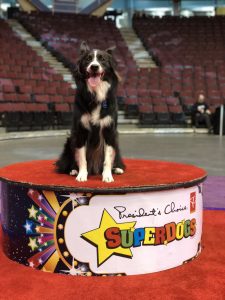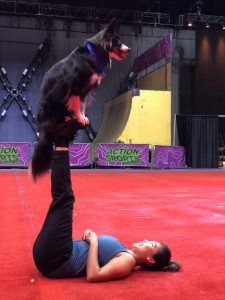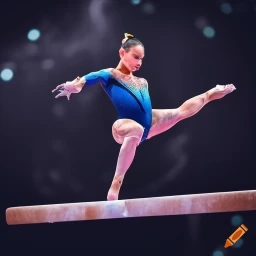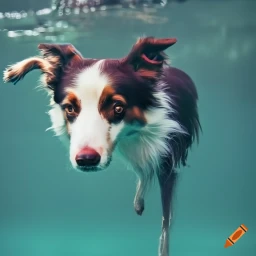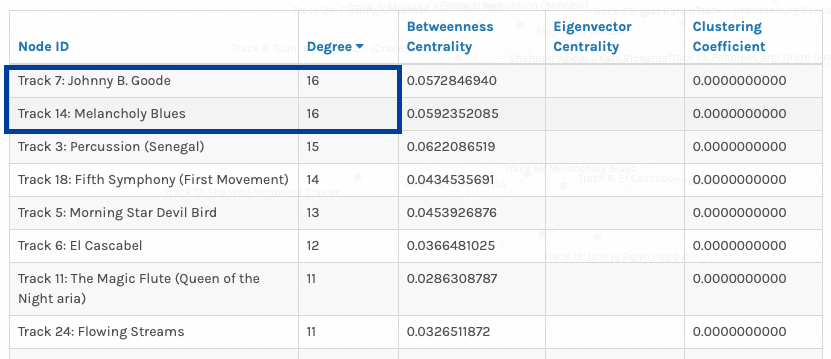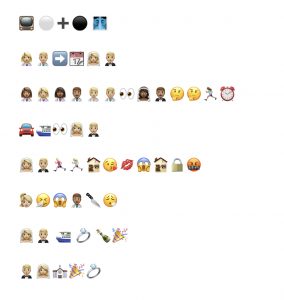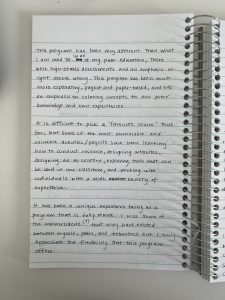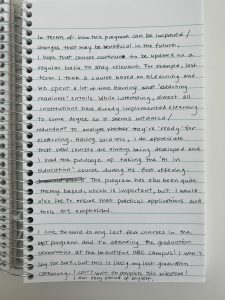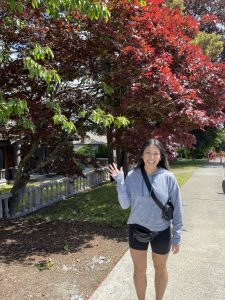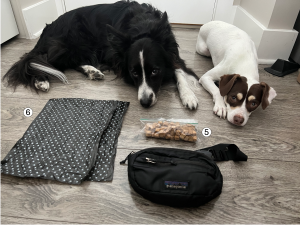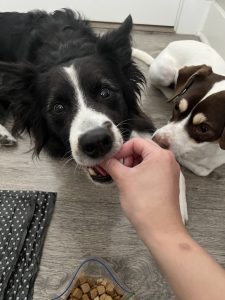The following text was captured using the dictation feature, converting my oral speech to text in the Notes application on my iPhone:
This is a story of how my dog Max and I performed with the super docs. If you have never heard of the super dogs, they are a group of performing dogs that perform at events around the world. We had the opportunity to perform with the super dogs in Vancouver at the PNE, Vancouver, pacific national exhibition, the PNE is an annual event in Vancouver and takes place during the last two weeks of the summer. It is an outdoor fair with lots of events and activities for people of all ages. I have fond memories going to the PNE as a child, playing games and winning prizes, eating food at the fair walking through the marketplace, but my favourite event of all times was always the super dogs are our journey to perform with them started much earlier in the year in January or February when our good friend and trader Lisa who has been involved with the super dogs for years, let us know that she would be hosting super dog auditions at the pet lover show local pet event being held in Abbotsford, BC she invited us to go audition, where we would get to see how our dogs did performing in front of an audience. We got to partake in a few different events, the dog agility component where the dog runs through tunnels over jumps, and even through the weaves, the high jump event, and a freestyle event, where Max and I showcase his tricks The auditions went well. Max stayed focussed on me the entire time. Of course I was holding the most high value treats. I could think of to keep his attention but overall he did incredibly well and surpassed my expectations in terms of how focussed he could be in front of an audience we fast forward to the summer time when we got a message from Lisa asking if we were available for an apprenticeship position with the super dogs the last weekend in August we were ecstatic to be given the opportunity to perform with the super dogs I recall pulling into the parking lot, walking through the back entryway of the Pacific Coliseum, where the super dogs performance was held and it was such a weird experience to be backstage with for so many years. I had only been a spectator from the other side, I recall being able to walk out onto the floor, a huge floor with empty seats all around to warm up, I recall getting a super dogs uniform to put on which made it feel very real. Max and I participated in a couple of different events the first being the relay races which is a fan favourite where the super dogs are split into two teams and one by one the dogs run through an agility obstacle course and which ever team completed the fastest wins this goes on as the audience is cheering for their team and overall it’s a very fun event for both the dogs and the audience. We also participated in the high jump event where we started by bringing out the small dogs who could only do a few bars high of the jump, we were in the middle of the class, and then after us, we brought all the dogs who could jump even higher than us, we participated in the weaving event which is one of maxes favourite agility obstacles, and I remember feeling so proud of him as he completed the different events and obstacles with is not bothered at all by the loud music lights or audience, even with all the excitement going on my self as a handler, had one job and it was to pay attention to my dog and to meet him that connection with my dog and I think we are Chief that after the show which lasts around 60 minutes, the team got to eat and take a break and we also stretched as a group because the shows are not only physically demanding for the dogs but also for the humans we participated with the super dogs for three days on that Labour Day long weekend which meant three days of three shows a day for a total of nine performances it was an exhausting three days but one of the most memorable weekends I’ve ever had with Max and I’m so proud to be able to say that he is a super doc
Reflection & Analysis:
How does the text deviate from conventions of written English?
Firstly, seeing my story as one large paragraph is not appealing and highlights the lack of formatting achieved using the dictation feature. Had my story been presented following conventions of written English, components including a title, headers, paragraphs, and spacing would have been incorporated to help separate different ideas within my story.
The text also contains some grammar and punctuation errors that would likely not be present had my story been written instead of orally conveyed. For example, the term ‘most high value’ was used instead of saying ‘highest value’, a grammar mistake that came out while speaking, that would have been corrected if written. From a punctuation perspective, there are several run-on sentences and some misuse of punctuation (commas and periods) that capture the pace and tone of how my words were spoken, but don’t confirm to proper grammar or sentence structure of written English.
What is “wrong” in the text? What is “right”?
Let’s start with what is right – of the 748 words in the text, over 97% of the words are spelled correctly. The voice-to-text feature did well in this regard.
Where it wasn’t so effective and got things wrong, was mostly in the spelling of names and the punctuation used throughout the text. There were two names used throughout my story – the organization called Superdogs and my dog named Max. The name ‘Superdogs’ was often captured as ‘super docs’ or ‘super dogs’ which is reasonable given that the name of the organization is not part of the common English vernacular and the voice-to-text software broke this name into two, more common words in the English language. My dog’s name Max was appropriately spelled, except for one instance where the word ‘Max’s’ was spelled as ‘maxes’, likely since the software did not know I was referring to a being.
There is also a lack and misuse of punctuation. I enabled my iPhone’s Auto-Punctuation setting and instead of vocalizing punctuation such as ‘comma’ or ‘period’, which would not be included in oral storytelling, I allowed the voice-to-text feature to add the appropriate punctuation. Several commas and periods were missing, resulting in run-on sentences. In a couple of instances, periods were misplaced, often before the word ‘I’, such as in the following two sentences:
- Of course I was holding the most high value treats. I could think of to keep his attention…
- …it was such a weird experience to be backstage with for so many years. I had only been a spectator from the other side…
What are the most common “mistakes” in the text and why do you consider them “mistakes”?
The most common mistakes in the text relate to the lack and misuse of punctuation. I consider them mistakes as they change the pace at which the text is read. For example, commas and periods indicate pauses within and between sentences and can be used to emphasize different ideas.
The following text at the end of my story is one very long, run-on sentence. The lack of punctuation not only makes it difficult to read, but also removes some of the emphasis placed on certain sentences.
We also participated in the high jump event where we started by bringing out the small dogs who could only do a few bars high of the jump, we were in the middle of the class, and then after us, we brought all the dogs who could jump even higher than us, we participated in the weaving event which is one of maxes favourite agility obstacles, and I remember feeling so proud of him as he completed the different events and obstacles with is not bothered at all by the loud music lights or audience, even with all the excitement going on my self as a handler, had one job and it was to pay attention to my dog and to meet him that connection with my dog and I think we are Chief that after the show which lasts around 60 minutes, the team got to eat and take a break and we also stretched as a group because the shows are not only physically demanding for the dogs but also for the humans we participated with the super dogs for three days on that Labour Day long weekend which meant three days of three shows a day for a total of nine performances it was an exhausting three days but one of the most memorable weekends I’ve ever had with Max and I’m so proud to be able to say that he is a super doc
I wonder whether the auto-punctuation feature of other voice-to-text tools may have better captured more appropriate punctuation, or whether my tone, pace and enunciation could be clearer.
What if you had “scripted” the story? What difference might that have made? In what ways does oral storytelling differ from written storytelling?
If I had scripted the story versus shared it orally, it would have included components such as a title and paragraphs to help provide context and to break up different ideas and make it more visually appealing and easier to read. Note that at the beginning of this task, I was inclined to add one sentence that was not part of my oral story, but that I felt helped to add context to the text.
Oral storytelling can be much slower compared to written storytelling – the text above captures approximately 9 minutes of speech, but it took me less than 4 minutes to re-read. In oral storytelling, the speaker has control over the pace and tone of the story and can influence the story and characters by using different voices, or by emphasizing different parts of the story. In written storytelling, the reader has more autonomy over the pace and tone of the story. For example, if a story has characters, two readers may visualize or envision different voices for the same character very differently.
I hope you enjoyed my voice-to-text story! Were there parts of the story you didn’t understand due to the text captured? Have any of you watched the Superdogs at the PNE before?
Just for fun, this is Max as a Superdog!
